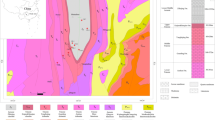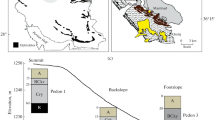Abstract
Terra rossa samples were taken from the B horizons of soil profiles and from cracks within limestone in Italy. The average annual temperature (AAT) of the sites ranged from 8.4 to 20.3°C and the average annual precipitation (AAP) from 511 to 3113 mm, with either a 5–6 month water deficit or a large water surplus. Goethite and hematite were identified in all the samples. Under a moist (> 1700 mm AAP) and cool (13°C AAT) climate, a xeric, hematitic pedoenvironment was preserved by the well-litified carbonate rock. Hematite occurred in trace amounts, even with an AAT of 8.4°C and an AAP of 3300 mm, confirming the specific role of the hard limestone on the pedoclimate of terra rossa. The lowest mean crystallite dimension of goethite and hematite was found in the samples from the wettest sites, and in these samples hematite was nearly free of Al substitution. Rubification in terra rossa appeared to be due to the specific pedoenvironment. The hematite cannot be considered a relict phase formed under another climate. Mite and kaolinite were the main clay minerals in samples from xeric sites whereas more weathered clays, such as Al-interlayered vermiculite, occurred in cool, moist sites. We postulate that the processes of rubification and vermiculitization could have taken place at the same time.
Similar content being viewed by others
References
Barron, V. and Torrent, J. (1986) Use of Kubelka-Munk theory to study the influence of iron oxides on soil colour: J. Soil Sci. 37, 499–510.
Boero, V. and Schwertmann, U. (1987) Occurrence and transformation of iron and manganese in a colluvial terra rossa toposequence in northern Italy: Catena 14, 519–531.
Boero, V. and Schwertmann, U. (1989) Iron oxide mineralogy of terra rossa and its genetic implications: Geoderma 44, 319–327.
Bresson, L. M. (1974) A study of integrated microscopy: Rubefaction under wet temperate climate in comparison with mediterranean rubefaction: in Soil Microscopy, G. K. Rutherford, ed., Limestone Press, Kingston, Canada, 526–541.
Bresson, L. M. (1976) Rubéfaction récente des sols sous climat tempéré humide: Science du Sol 1, 3–22.
Bronger, A., Ensling, J., Gütlich, P., and Spiering, H. (1983) Rubification of terrae rossae in Slovakia: A Mössbauer effect study: Clays & Clay Minerals 31, 269–276.
Mehra, O. P. and Jackson, M. L. (1960) Iron oxide removal from soils and clays by a dithionite-citrate system buffered with sodium bicarbonate: in Clays & Clay Minerals, Proc. 7th Natl. Conf., Washington, D.C., 1958, Ada Swinford, ed., Pergamon Press, New York, 317–327.
Rabenhorst, M. C. and Wilding, L. P. (1984) Rapid method to obtain carbonate-free residues from limestone and petrocalcic materials: Soil Sci. Soc. Amer. J. 48, 216–219.
Rich, C. I. and Obenshain, S. S. (1955) Chemical and clay mineral properties of a Red-Yellow Podzolic soil derived from muscovite schist: Soil Sci. Soc. Amer. Proc. 19, 334–339.
Schulze, D. G. (1981) Identification of soil iron oxide minerals by differential X-ray diffraction: Soil Sci. Soc. Amer. J. 45, 437–440.
Schulze, D. G. (1984) The influence of aluminum on iron oxides. VIII. Unit cell dimensions of Al-substituted goe-thites and estimation of Al from them: Clays & Clay Minerals 32, 36–44.
Schwertmann, U., Fitzpatrick, R. W., Taylor, R. M., and Lewis, D. G. (1979) The influence of aluminum on iron oxides. Part II. Preparation and properties of Al-substituted hematites: Clays & Clay Minerals 27, 105–112.
Schwertmann, U., Murad, E., and Schulze, D. G. (1982) Is there Holocene reddening (hematite formation) in soils of axeric temperate areas?: Geoderma 27, 209–223.
Schwertmann, U. (1988) Some properties of soil and synthetic iron oxides: in Iron in Soils and Clay Minerals, Nato Advanced Study Institute, J. W. Stucki, B. A. Goodman, and U. Schwertmann, eds., Reidel Publishing Company, Dordrecht, Holland, 203–250.
Thornthwaite, C. W. (1948) An approach toward a rational classification of climate: Geog. Rev. 38, 55–94.
Torrent, J., Schwertmann, U., Fechter, H., and Alferez, F. (1983) Quantitative relationships between soil color and hematite content: Soil Sci. 136, 354–358.
Torrent, J., Schwertmann, U., and Schulze, D. G. (1980) Iron oxide mineralogy of some soils of two river terrace sequences in Spain: Geoderma 23, 191–208.
Author information
Authors and Affiliations
Rights and permissions
About this article
Cite this article
Boero, V., Premoli, A., Melis, P. et al. Influence of Climate on the Iron Oxide Mineralogy of Terra Rossa. Clays Clay Miner. 40, 8–13 (1992). https://doi.org/10.1346/CCMN.1992.0400102
Received:
Accepted:
Published:
Issue Date:
DOI: https://doi.org/10.1346/CCMN.1992.0400102




